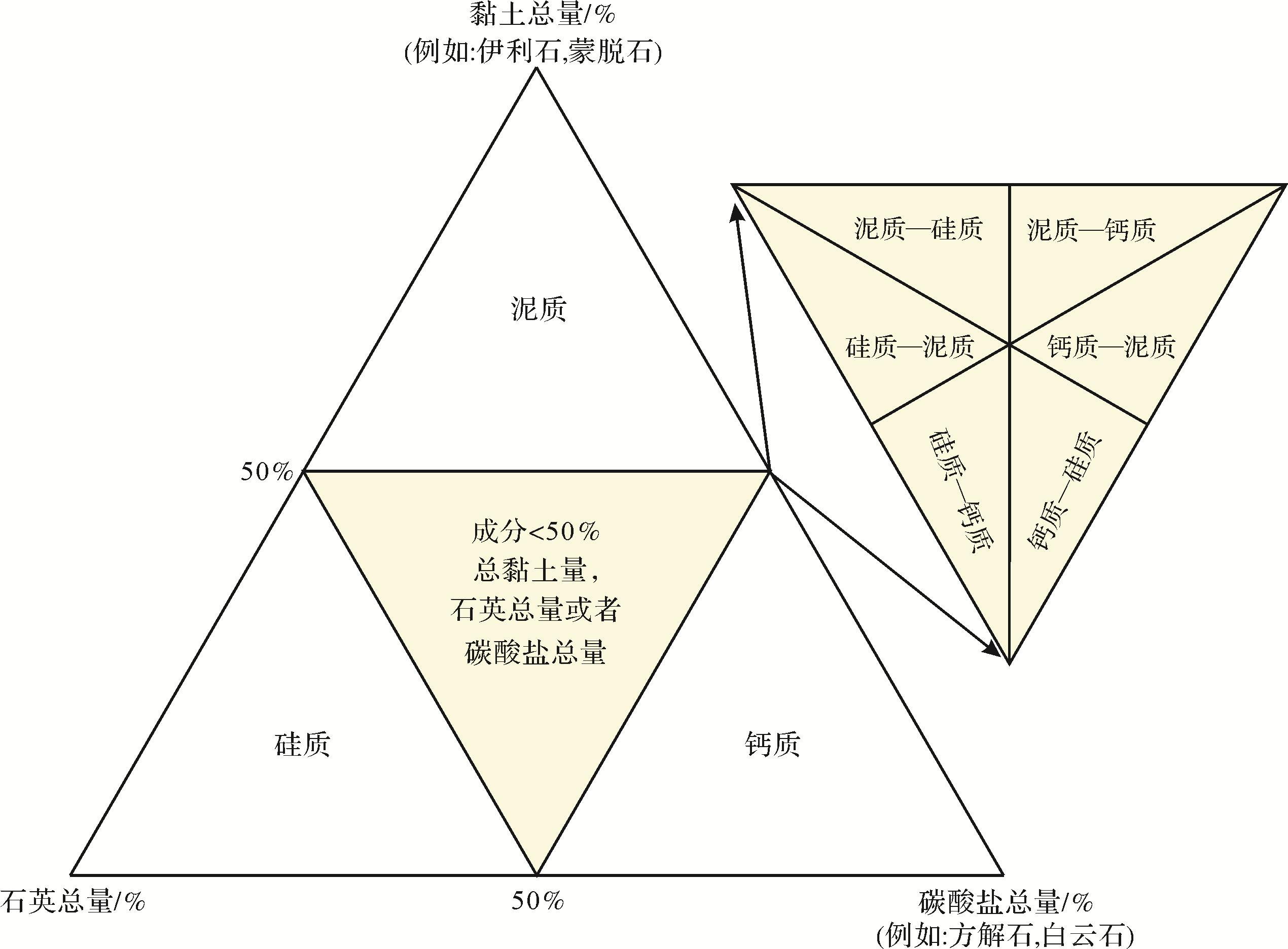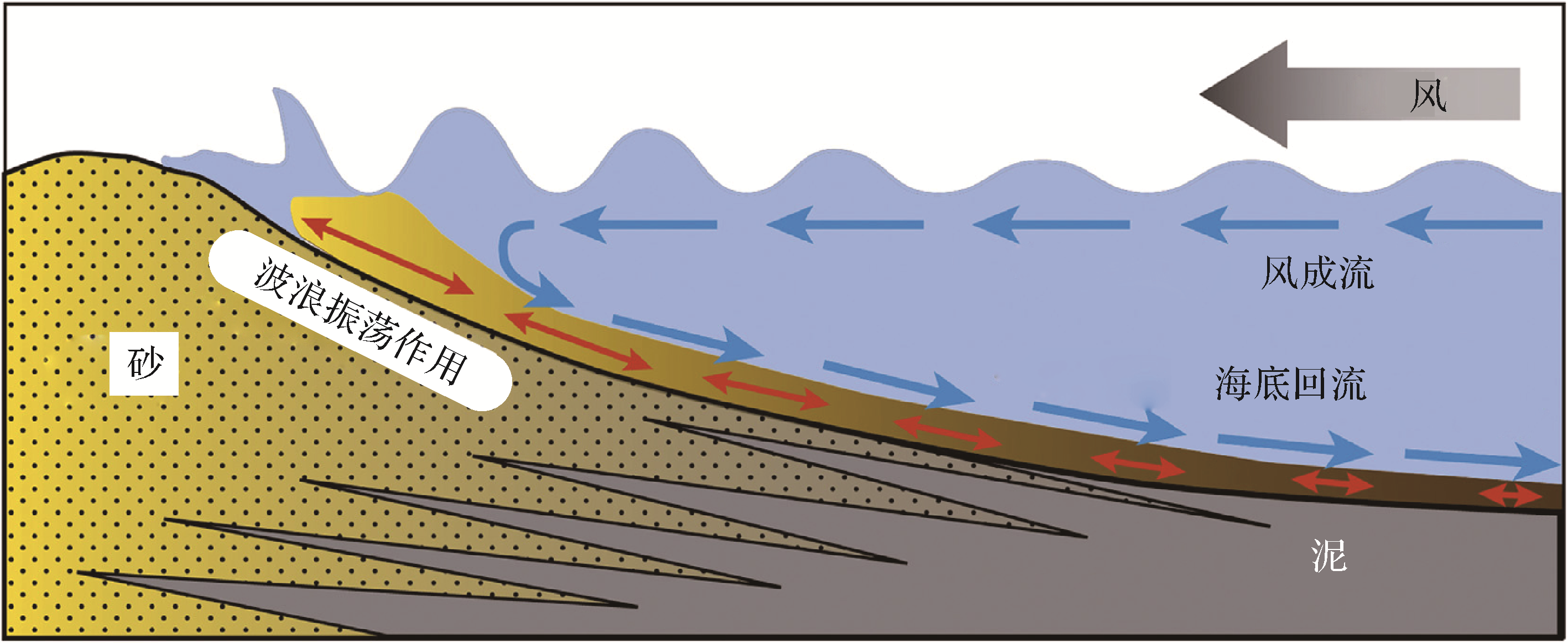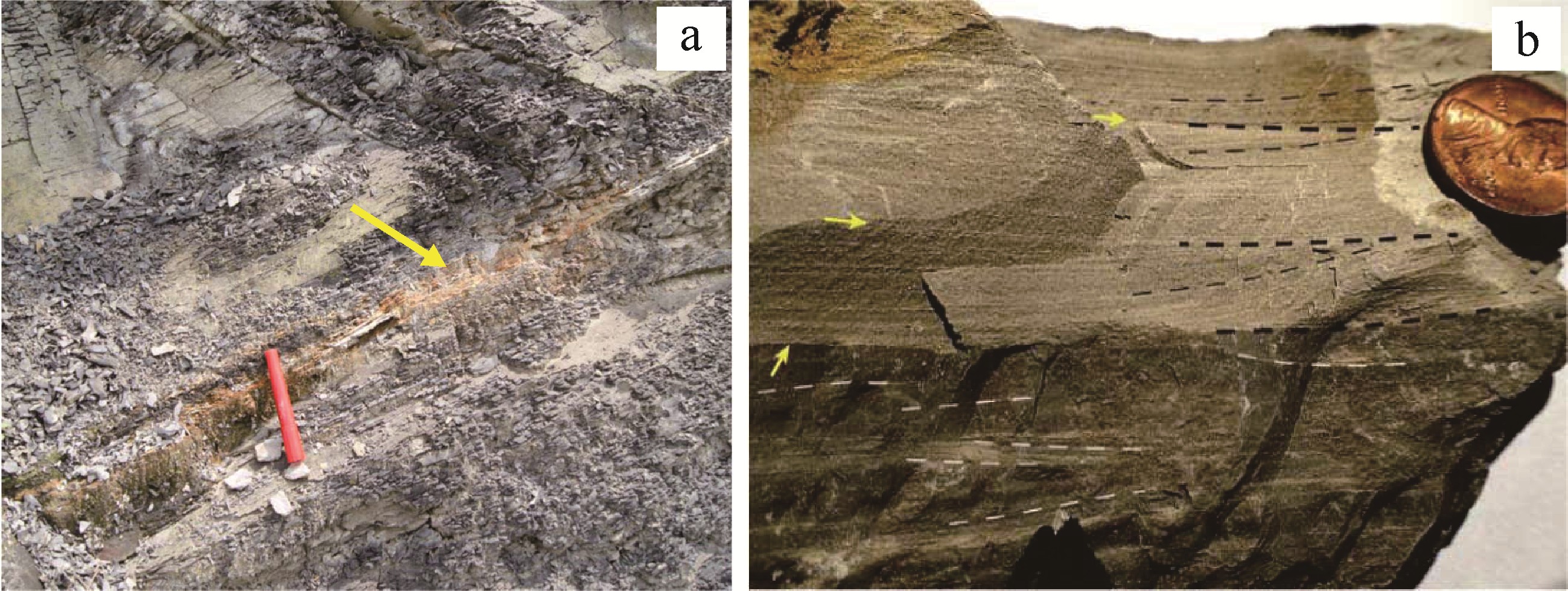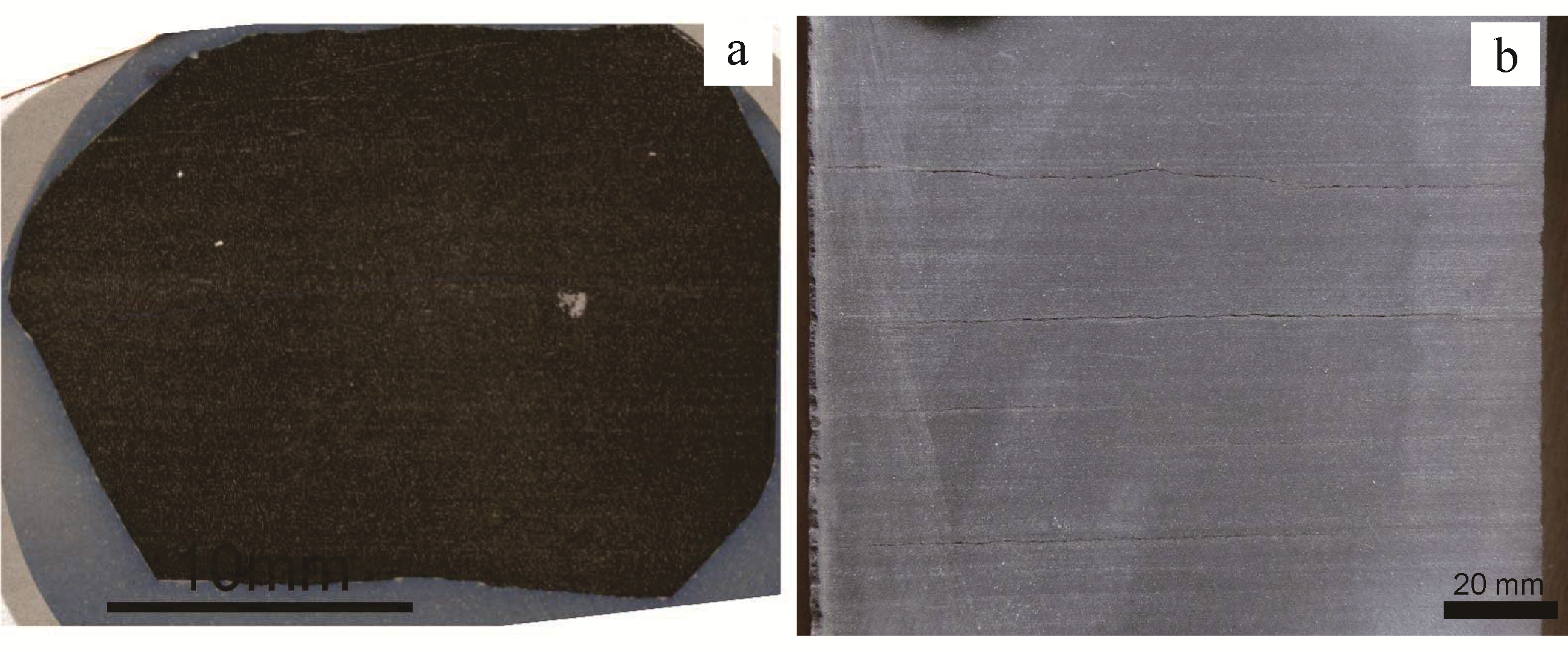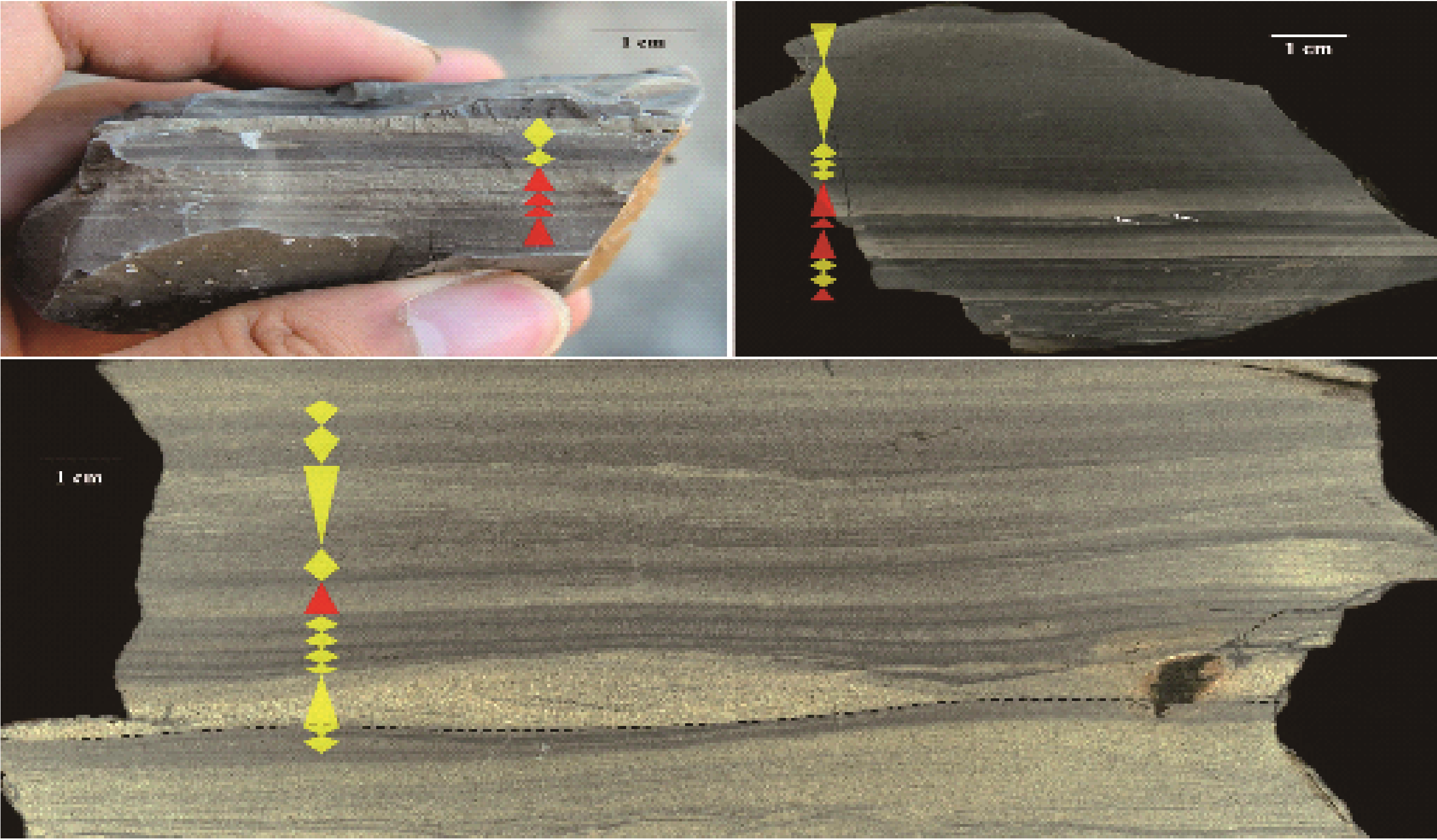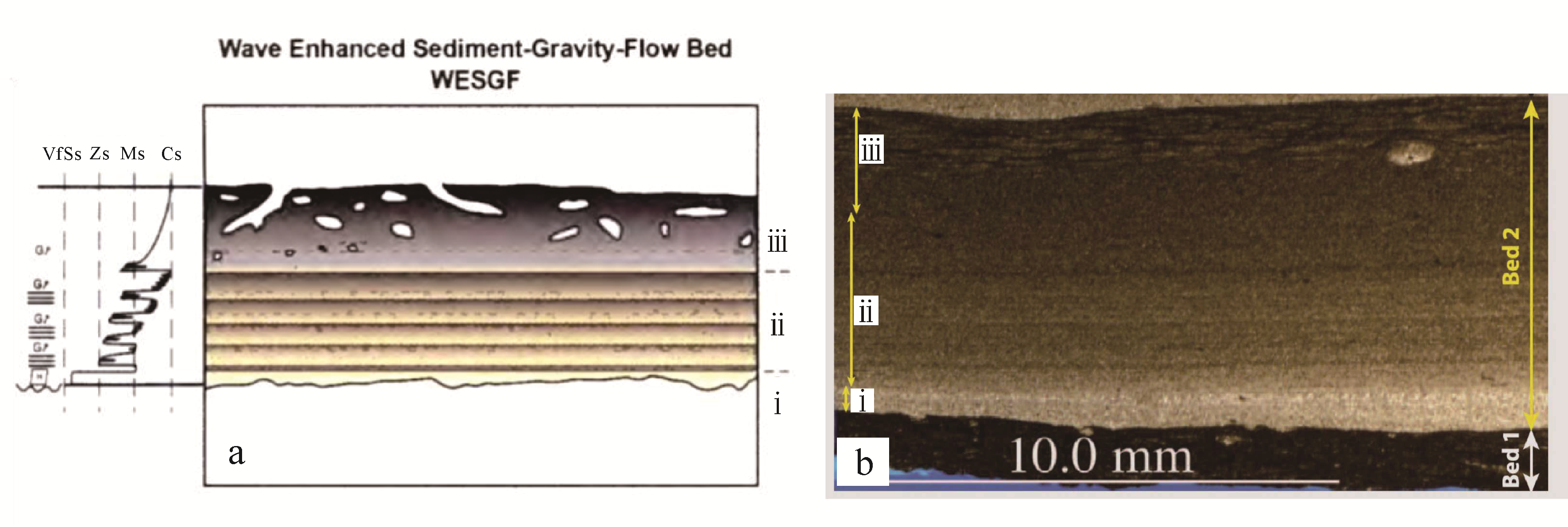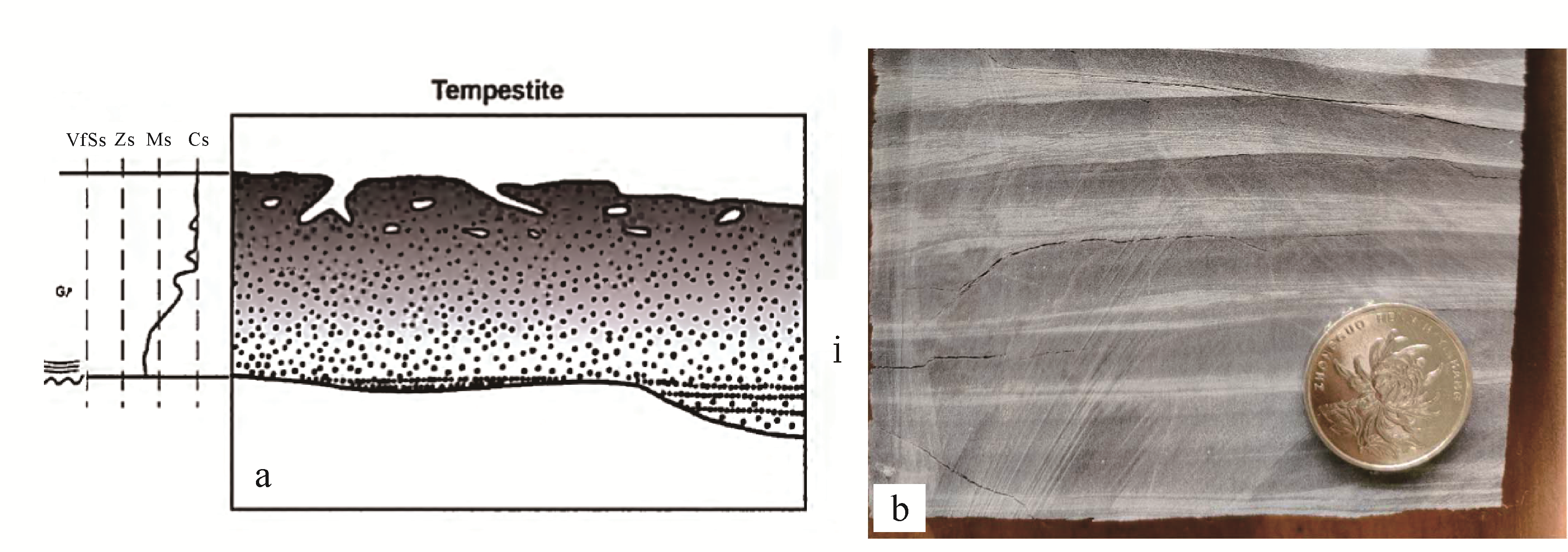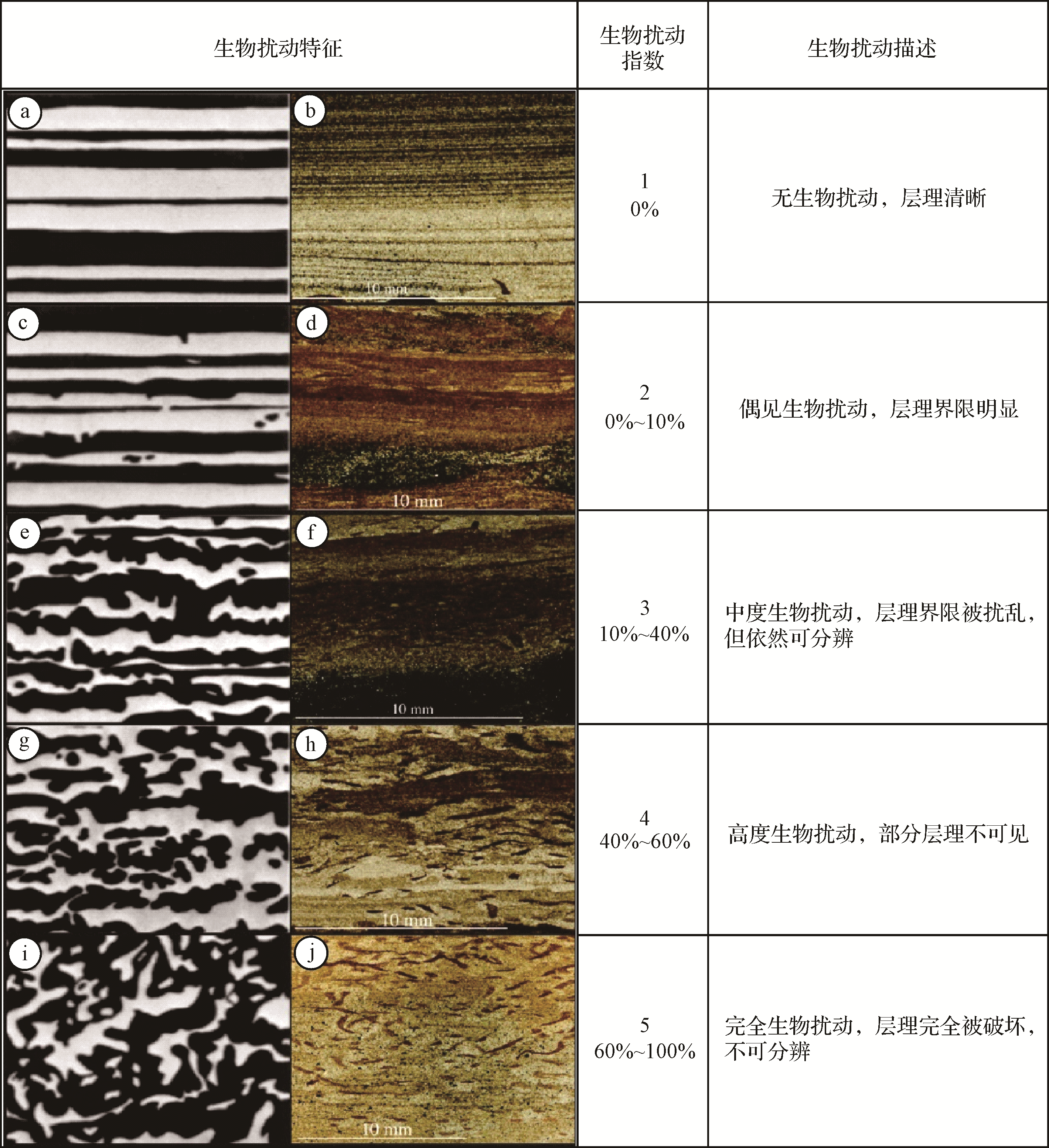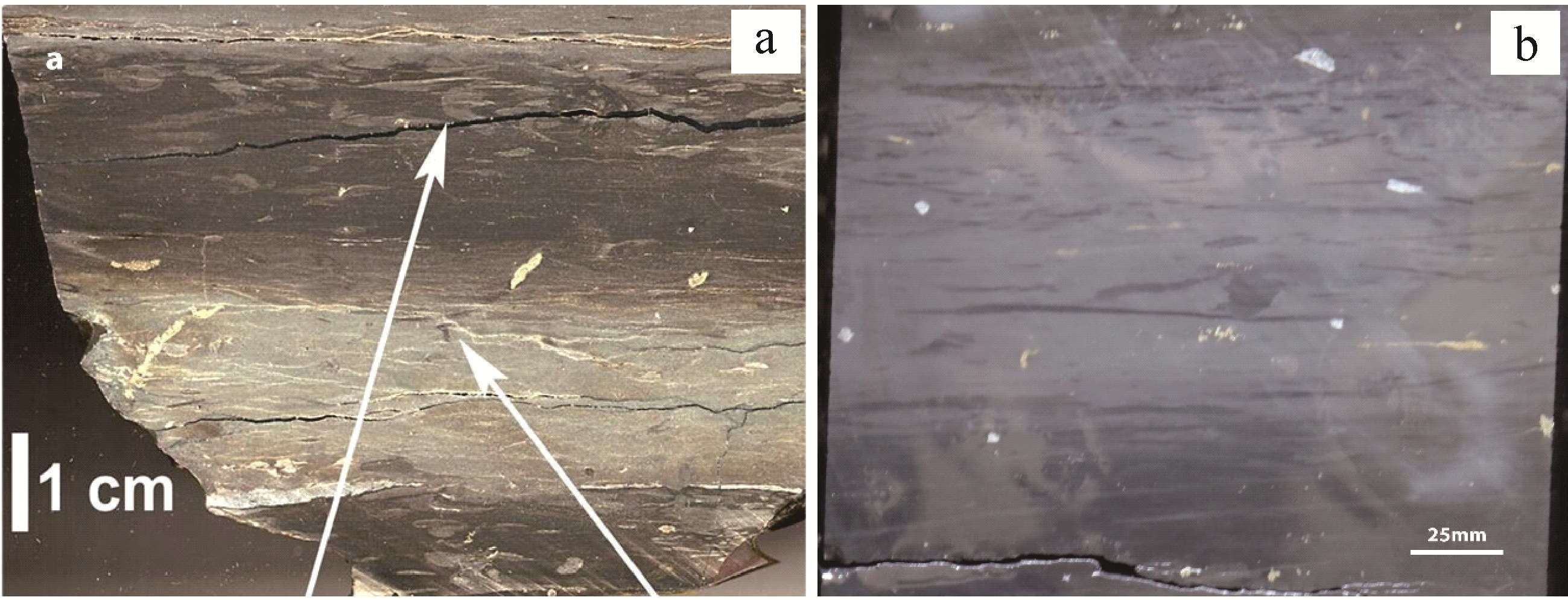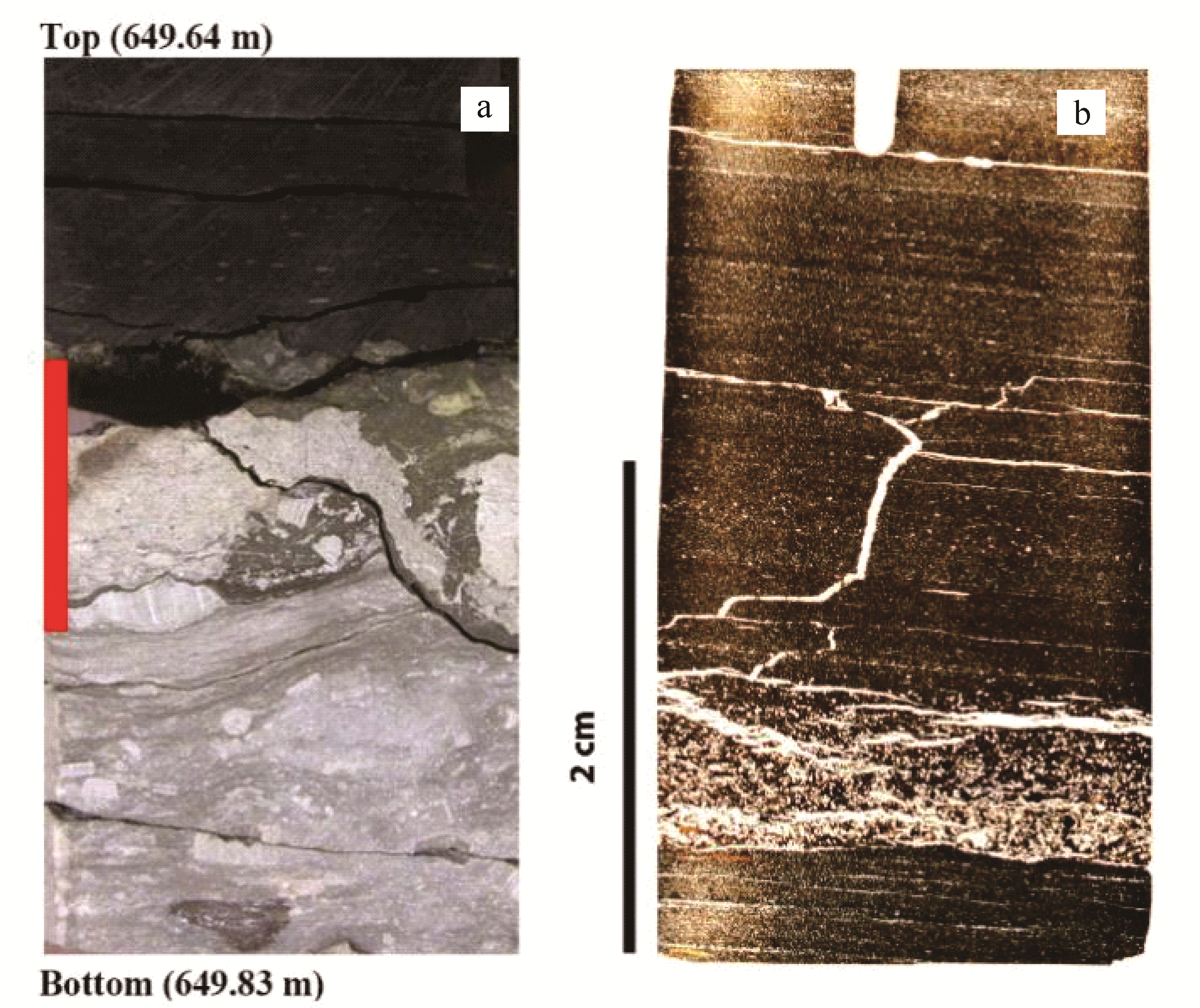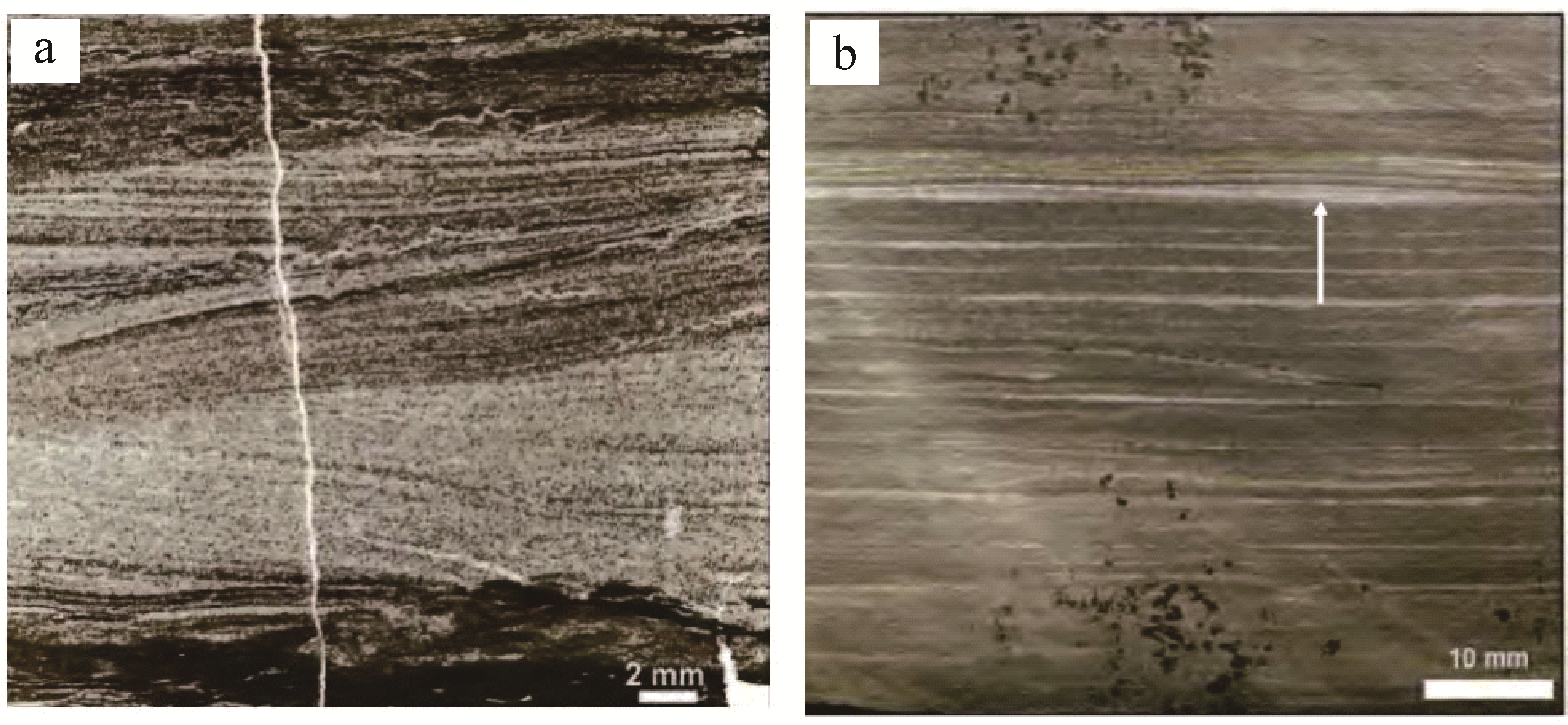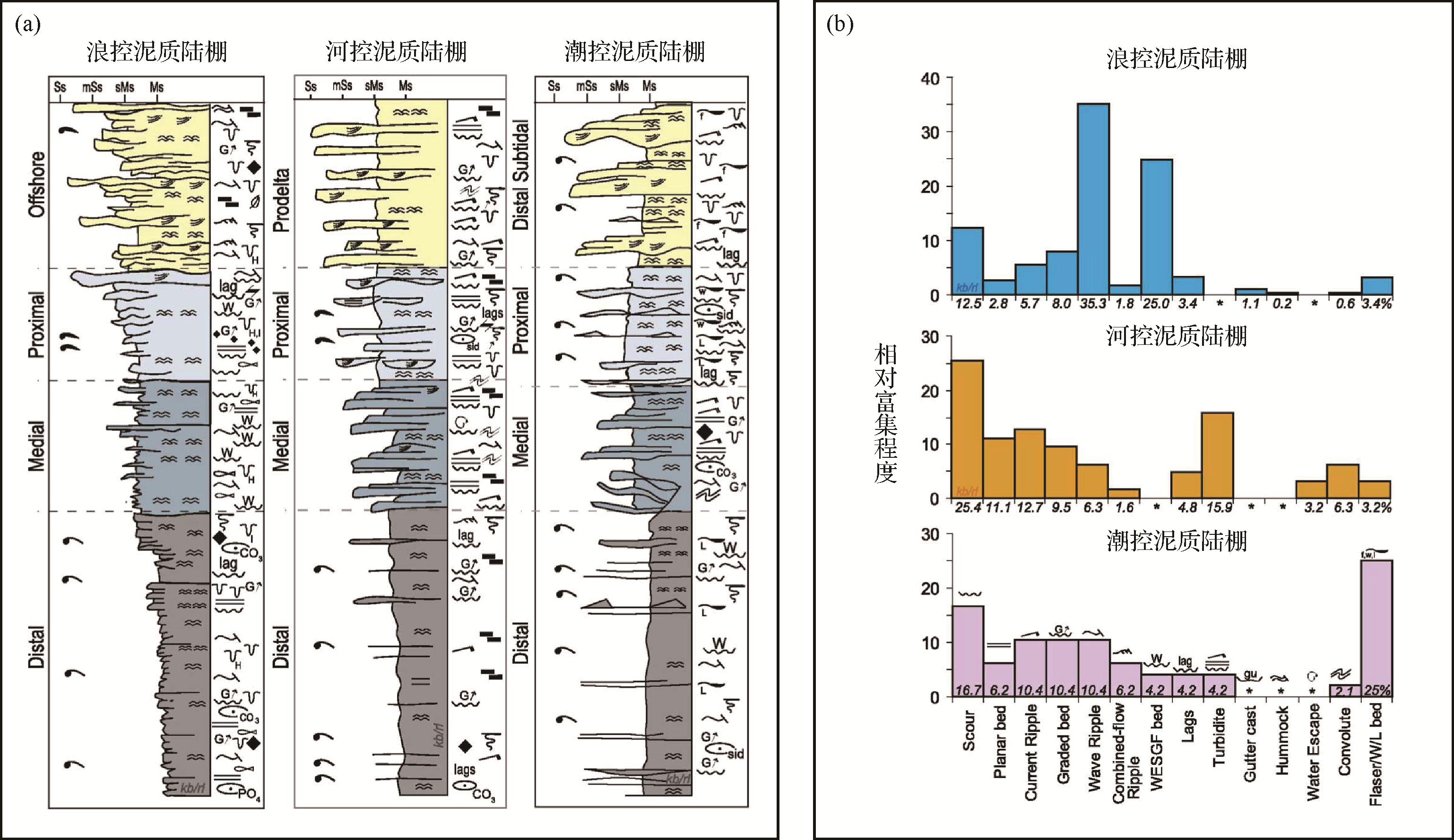HTML
-
泥页岩,即细粒沉积岩(fine-grained sedimentary rock),是指主要以颗粒粒级小于62.5 µm的细粒沉积物组成(含量大于50%)的沉积岩[1-3]。泥页岩这一术语,实际上是泥岩(mudstone)或泥状岩(mudrock)与页岩(shale)的统称。过去普遍认为页岩专指风化条件下页理极为发育的细粒沉积岩,而泥岩则页理不发育,然而,对风化程度较低的新鲜样品而言,很难通过所谓的页理发育程度判断其为页岩还是泥岩,因此,“页理发育”这一标准并不是规范的岩石学判断标准。在国外,“泥岩”是学术界标准的沉积岩石学术语,而“页岩”则是油气工业界广泛应用的生产术语,二者的本质定义均为细粒沉积岩。由此看来,所谓“泥岩”与“页岩”的区分,更多地是一种应用习惯的区分,并无岩石学性质上的根本差异。本文泛称为“泥页岩”,实则是为了兼顾各方的应用习惯。
泥页岩是地球上分布最广的沉积岩类,其在沉积岩中的占比超过了三分之二[1,4]。过去,人们对泥页岩的关注多集中于其较高的有机质含量(主要的烃源岩)、较强的封闭性能(良好的盖层)、富集的金属元素含量(有效的矿层)以及保存连续的沉积地球化学记录(古气候、古环境的记录载体),而对泥页岩沉积特征和沉积过程的研究较少。对泥页岩沉积学的研究主要起源于上世纪80年代,1980年“页岩之父”Potter et al.[5]编著的Sedimentology of Shale是第一部系统阐述泥页岩沉积特征和沉积过程的论著,随后Wignall[6]编著的Black Shales(1994)和Schieber et al.[7]撰写的Shales and Mudstones(1998)则对泥页岩的沉积环境和成因进行了进一步的梳理,然而,这一阶段对泥页岩形成过程的认识尚未完全打破传统观点,其沉积特征多被描述为“均质的”、“无沉积构造的”、“块状的”或者“层状的”,并解释为静水条件下悬浮沉积的产物[5,8-9],其丰富的有机质含量是厌氧环境所致[6]。
进入21世纪之后,受美国“页岩气革命”的影响,人们对泥页岩微观非均质性特征日益关注,识别出了丰富多样的沉积构造现象,揭示了泥页岩可在多种水动力条件下形成,其中,Schieber于2007年在Science上发表的水槽实验文章表明纹层状页岩可在高能水动力条件下形成[10],打破了传统认知,至此,泥页岩沉积学研究进入了新阶段。在这一阶段,对泥页岩沉积过程的研究集中在水槽模拟实验、毫米—厘米级岩相微相识别与水动力条件解释、以及高精度层序地层单元划分,而这些研究大部分都是针对海相泥页岩。作为非常规油气沉积学的重要组成部分,海相泥页岩沉积过程研究能够为源岩、储集岩等特征分析及相关地质事件追溯提供基础信息,预测其空间分布,是非常规油气勘探的核心基础研究[11]。本文通过梳理近年来关于海相泥页岩沉积过程研究的相关文献,结合研究实例,介绍海相泥页岩岩相分类方案、沉积过程与沉积特征和层序地层学的新进展,期望能够引起读者的关注与讨论,共同推动非常规油气沉积学的深入发展。
-
由于泥页岩的沉积特征不明显,对如何命名和描述该类岩性一直具有很大的争议性。随着对细粒沉积岩观察描述的不断深入,许多学者发现泥页岩是非均质性的,并可以在多种沉积过程中形成[12-18]。因此,传统的命名方法已无法表现细粒沉积岩的物理、生物和化学属性,也无法解释泥页岩形成的沉积过程。
国内学者对泥页岩的分类方案进行过有益的尝试,姜在兴等[3]通过对比海相和陆相细粒沉积岩的相似性和差异性,建立以成岩组分粉砂、黏土和碳酸盐为三端元、以各自含量50%为界限进行细粒沉积岩命名的方案,将细粒沉积岩分为粉砂岩、黏土岩、碳酸盐岩和混合型细粒沉积岩。冉波等[19]对国内的分类进行了归纳总结,认为国内分类标准大致是基于纹层特征、矿物成分、生物特征和颜色等要素[20-22],并提出了以纹层发育程度和石英百分含量为指标的分类方法,将纹层分为平行纹层、不平行纹层和不明显纹层,以石英含量≤40%为贫硅,40%~60%为中硅,60%~80%为富硅,≥80%为硅质岩,该分类方案主要针对的是五峰组—龙马溪组黑色页岩段。上述对泥页岩分类方法的探索促进了我国对细粒沉积岩的研究和进一步认识。
国外学者对泥页岩的命名方法进行过有益的尝试[5,23⁃24],其划分参数多集中在矿物成分、颗粒大小与含量和纹层厚度。Lazar et al.[25]通过归纳总结前人的命名方法优点,提出了一套简单实用的命名方法,迅速取得了国际学术界和工业界的认可并得到了广泛应用。Lazar的方案既最大限度地继承了传统沉积岩石学的基本命名原则[26-27],即以颗粒粒度、层理特征和矿物成分进行命名,又融入了细粒沉积岩的特殊属性,因此这个方案易理解且便于普遍应用。在结构(粒度大小)方面,Lazar et al.[25]沿用了三端元分类法,分别以砂级、粗泥级和细泥级作为三个端元[4,23,25-26,28](图1)。其中细泥级(黏土级—极细粉砂)颗粒粒度小于8 µm;中泥级(细粉砂—中粉砂级)颗粒粒度为8~32 µm;粗泥级(粗粉砂级)颗粒粒度为32~62.5 µm;砂级的粒度范围为62.5~2 500 µm。根据这个分类,泥岩被定义为粉砂级及以下颗粒含量大于50%的细粒沉积岩。在泥岩范畴内,当砂级颗粒含量在25%~50%之间时,定义为砂质泥岩。当砂级颗粒含量小于25%时,泥岩又可以进一步划分为粗粒泥岩(粉砂岩)、中粒泥岩(狭义的泥岩)和细粒泥岩(黏土岩)。粗粒泥岩(粉砂岩)是指粉砂级及以下颗粒内有三分之二的颗粒为粗泥级(粗粉砂级);细粒泥岩(黏土岩)是指是指粉砂级及以下颗粒内有三分之二的颗粒为细泥级(黏土级);中粒泥岩(狭义的泥岩)是指粗泥级和细泥级颗粒含量均未超过三分二的过渡性细粒沉积岩。这里需要读者们注意一下其中各级泥岩与传统上粉砂岩、泥岩及黏土岩的对应关系。

Figure 1. Nomenclature guidelines for mudstones and shales: texture grain size (modified from Lazar et al.[25])
层理方面,Lazar et al. [25]将层理根据大小级别分为纹层、纹层组和层,并根据纹层的连续性(连续或者不连续)、形态(板状、波状或者曲线状)和几何关系(平行或者不平行)对层理进行了划分(图2)。层理的厚度和形态特征反映了不同的沉积条件。

Figure 2. Nomenclature guidelines for mudstones and shales: geometry of bedding (modified from Lazar et al.[25])
在矿物成分方面,Lazar et al. [25]仿照砂岩和碳酸盐岩的分类方法,以黏土矿物含量、石英含量和碳酸盐矿物含量为端元,以50%为含量界限,将细粒沉积岩分为了黏土质、硅质和钙质(图3)。例如,泥岩的石英含量若为60%,则称之为硅质泥岩。若三种成分的含量均未超过50%,则以最多的两种成分排序命名。比如,若粗粒泥岩黏土矿物含量为40%,石英含量为45%,碳酸盐含量为15%,则命名为硅质—黏土质粗粒泥岩。值得注意的是,该命名原则的成分排序与国内传统岩石学命名的成分排序刚好相反,即主要成分排在前,次要成分排在后,在国内应用时可做适当调整。除了这三大类主要成分,若其他的成岩成分(例如磷酸盐、长石和有机质)含量显著,则可以对三端元法进行部分修正。比如,磷酸盐含量位于0.2%~20%范围的可称为磷酸质泥岩,而磷酸盐含量大于20%则称为磷块岩;长石含量大于25%称为长石质泥岩,位于5%~25%的称为亚长石质泥岩;TOC含量在2wt.%~25wt.%的称为碳质泥岩,而TOC含量在25wt.%~50wt.%的称为干酪根质泥岩或者煤质泥岩。

Figure 3. Nomenclature guidelines for mudstones and shales: composition (modified from Lazar et al.[25])
-
随着对现代和古代海洋环境泥(岩)观察的不断深入,前人在泥(岩)中发现了丰富的沉积构造特征,包括毫米至厘米级别的平行层理与丘状交错层理、波状层理、包卷层理、透镜状纹层、波纹、冲刷面、粒序与反粒序递变层和生物扰动构造等[12-18]。多样的沉积构造特征表明,泥页岩的沉积过程十分复杂,可受到河流洪水(异轻流和异重流)、风暴波浪、重力流等多种因素影响(图4,5)。而与正常陆棚海环境相比,陆表海细粒沉积物的沉积过程除上述水动力条件外,还可能受远岸底流的控制[29],该理论近年来已在水槽模拟实验中得到了证实[10,30-31]。下面,本文将对海相泥页岩的主要沉积过程及沉积特征进行概述。

Figure 4. Schematic model for Hypopycnal plume, hyperpycnal flows and wave⁃current enhanced sediment gravity flows (modified from Schieber[29])

Figure 5. Schematic model for storm induced offshore transport (modified from Schieber[29])
-
风成输入主要包括沙尘和火山灰。沙尘会在沙尘暴的作用下沉积到远岸的海洋里,比如在大西洋的中央位置发现有来自撒哈拉沙漠的风成沉积物[32]。剧烈的火山喷发会产生大量火山灰,漂浮到远洋,沉积下来形成火山灰层(钾质斑脱岩)[33]。细粒沉积岩中的火山灰层是很好的等时标志层,比如在上扬子地区的五峰组—龙马溪组以及美国犹他州上白垩统页岩的钾质斑脱岩都是很好的地层对比标志层[34-35](图6a)。一般来讲,沙尘和火山灰飘落沉积下来是没有明显沉积特征的,然而,一些沙尘或者火山灰在沉积过程中可能会受到底流作用的改造,具有一定的层理特征(图6b)。

Figure 6. (a) K⁃Bentonite layer in the Longmaxi Formation, Xishui, Guizhou; (b) Reminiscent of hummocky cross⁃stratification in a bentonite layer of the Tropic Shale, Utah, U.S.[29]
-
异轻流主要由河流输入的泥质悬浮沉积组成,漂浮于高盐度和高密度的海水浅层,其漂浮范围一般可达离岸几十公里[36-37],在沿岸流的作用下甚至可以漂浮到离岸几百公里的范围[38],比如在墨西哥湾,密西西比河输入的异轻流分布范围十分广阔。
未被其他水动力条件(如波浪、底流等)的异轻流会以悬浮沉积的方式沉积下来,形成水平纹层。水平纹层的特征表现为内部无粒序变化,分选作用弱,纹层边界模糊,呈渐变变化。整体而言,水平纹层属于被动沉积过程的结果,反映了较弱的水动力条件。在上扬子地区五峰—龙马溪组以及牛蹄塘组(或筇竹寺组)页岩的部分层段中可见水平纹层(图7)。
-
在细粒沉积物从滨岸向远岸搬运的过程中,重力作用是重要的动力驱动机制,在重力的作用下,流体会从高势区流向低势区,因此,一定的坡度是产生这些搬运沉积过程的必要条件。重力驱动下的沉积过程主要包括前三角洲浊流、异重流、浪控沉积物重力流以及风暴流。
-
当河流入海建设三角洲时,会在前三角洲区域形成相对较陡的斜坡,而前三角洲浊流就是由前三角洲斜坡的垮塌引起的涌流型浊流,其持续时间较短,搬运距离为几公里[39],搬运所需的最小坡脚为0.7°。
浊流在沉积过程中,随着能量的减弱,其主控沉积物搬运机制表现为沉积物重力流—牵引搬运—悬浮沉积的变化过程。因此,浊流沉积具有典型的垂向变化序列,其识别标志如下:顶面多见生物潜穴,相对整合接触;内部:整体上为正粒序,分为5个纹层组:ⅴ.最细粒,为层理模糊的递变纹层组;ⅳ.连续—不连续的平行纹层组,顶部整合接触;ⅲ.不连续、弯曲、不平行的纹层组,下超于下伏地层,相对粗粒;ⅱ.连续平行的纹层组,相对粗粒;ⅰ.均质纹层组,上超于侵蚀面,粒度最粗;底面:侵蚀面,弯曲状—波状,中—高起伏,常见沟槽、压刻痕等[40](图8)。
-
异重流是指河流输入中的高密度流体,其密度大于海水,因此是以底流的方式从前三角洲斜坡向远岸岸方向搬运[41](图4)。由于异重流的产生需要高密度河水,因此可由超大洪水或者是在潮湿环境下的高山地区河流中产生[42]。海水的盐度、气候的变化以及风化程度的变化都会影响异重流的产生[29]。异重流搬运所需的最小坡角为0.7°[43]。
完整的异重流沉积表现为对称的粒序变化,即下半部为逆粒序层理,上半部为正粒序层理,这一层理特征体现了异重流搬运能力由弱到强再由强到弱的变化周期(图9)。然而,由于最大洪水期常常伴随着强烈的侵蚀作用,异重流沉积的上部经常被侵蚀,多呈现出以逆粒序特征为主的不完整沉积序列[41]。

Figure 9. Photo of Ferron mudstone with multiple thin inverse-normal graded hyperpycnite layers (modified from Li et al.[44])
-
浪控沉积物重力流是由异轻流或者异重流(近三角洲区域)等沉积下来的沉积物在风浪和底流的作用下进行二次搬运和沉积[43,45-47](图4)。由于有风浪和底流作用的助力,该流体搬运所需的坡度相对较小,最小可为0.03°[45-47]。
浪控沉积物重力流的沉积搬运机制表现为在风暴浪或者底流的搅动下,大量细粒沉积物悬浮起来形成高密度流体向下坡搬运,波浪的搅动使沉积物保持悬浮状态,斜坡产生的重力作用使沉积物以平流的状态向远岸搬运,纵向上表现从牵引搬运—沉积物重力流—悬浮沉积的转换过程,因此,其沉积整体上也是一套正粒序层理[43,48](图10)。其识别标志表现为:顶面多见生物潜穴;内部:ⅲ. 富黏土级纹层,正粒序变化,ⅱ. 多见极薄的曲状或波状层理,由粉砂级递变成黏土级,顶部渐变接触,ⅰ. 富粉砂、均质,具有不明显的粒序特征,顶部渐变接触;底面:侵蚀面,界面弯曲,低起伏(图10)[17]。
-
风暴流是指在风暴浪的作用下,在岸线形成了一个离岸方向运动的底流,风暴作用下形成的细粒沉积物主要沉积在远岸区域[49](图5)。风暴流搬运沉积物所需的最小坡脚为0.03°。与上述的沉积物重力流不同,风暴流的搬运动力主要为沿岸的下降流,重力的作用相对较小。然而,当该流体远离岸线时,其搬运能力逐渐降低,沉积物搬运机制表现为由混合流的侵蚀和牵引搬运向悬浮沉积的转换,因此,沉积序列也表现为正粒序特征(图11)。识别标志表现为:顶面多见生物潜穴,可见风浪改造;内部:整体上向上逐渐变细,纹层在底部为弯曲状,向上变平直;底部的纹层上超于侵蚀面,并充填下凹处;上部的纹层层理多模糊;底面:侵蚀面,弯曲状—波状,高起伏,常见小型沟槽。

Figure 11. (a) Schematic of a mud tempesite[40]; (b) Multiple tempesite layers in the Qiongzhusi Formation of Jingyan, Sichuan
-
前文所述的细粒沉积物搬运与沉积过程主要分布在陆棚海区域,其搬运的最远距离可达上百公里,搬运所需的最小坡度为0.03°。相较而言,陆表海的延伸范围更广,可达上千公里,坡度更缓,大部分区域坡度在0.001°~0.005°之间,显然,广大陆表海区域的细粒沉积物无法被上述的水动力能量所搬运[50-51]。近年研究表明,广大陆表海区域的细粒沉积物搬运机制主要为在潮汐作用或者季风作用下形成的远岸底流[28]。
水槽实验显示,在底流的作用下,细粒沉积物会形成砂级大小的絮凝状颗粒,以推移载荷的形式向前搬运,形成流水波纹[10,30-31]。流水波纹的识别特征如下:顶面:不对称波峰,顶超或者削截;内部:具有一定角度的前积层(<27°),下超于底界面,较粗粒纹层与较细粒纹层之间分界明显;底面:突变面或者侵蚀面,弯曲至平直。
然而,这种典型的流水波纹层理特征在古代海相泥页岩中并不明显,多在相对粗粒的粗粉砂层段出现,而在水槽实验中则可以看到较为明显的流水波纹现象[10,30-31]。出现这一反差现象主要是因为细粒沉积物的含水率很高,可达80%以上,早期形成的流水波纹在后期的压实作用下会形成“平行”层理或者低角度斜层理。在古代陆表海泥页岩中广泛分布的“平行”层理或者低角度斜层理都可能是底流作用下形成的流水波纹,有代表性的例如我国上扬子地区上奥陶统—下志留统页岩段(五峰组—龙马溪组)[52](图12a)以及北美上泥盆统页岩[53]、上白垩统页岩[54](图12b)。近期的水槽实验显示,流水波纹的形态差异(层厚及前积层角度)主要受控于流体速度和沉积速率[55]。
-
泥页岩中的生物扰动大多比较模糊,一般较少见到清晰的遗迹化石,经过抛光处理的样品其现象会相对明显。底栖生物的潜穴较少,其多在高含水的泥质沉积物中游动,扰乱原始的沉积结构;区域沉积环境对生物扰动指数有明显的控制作用;生物潜穴多受压实作用影响,变得模糊。生物扰动指数是有效指示生物扰动程度的参数,前人将其分为5级[56](图13)。根据生物扰动指数,可以有效地判断沉积环境。一般来说,较高的生物扰动指数可能代表了低能、浅水及有氧的沉积环境。早期研究一直认为富有机质页岩形成于厌氧环境,然而,在美国泥盆系Chattanooga黑色页岩中发现了丰富的生物扰动现象,扰动指数在4以上,这说明富有机质页岩可在相对富氧的环境中形成[57](图14a)。此外,五峰组黑色页岩一直也被认为是在厌氧环境中形成的,然而,近年笔者在五峰组底部发现丰富的生物扰动现象,扰动指数至少可达4,说明五峰组沉积早期应为有氧环境[55](图14b)。

Figure 13. Criteria for bioturbation index (modified from Taylor et al.[56])

Figure 14. (a) Bioturbation in the Chattanooga Shale, Tennessee, U.S. [57]; (b) Bioturbation in the basal of Wufeng Formation, Weiyuan, Sichuan
-
滞留沉积层是指下伏地层被侵蚀和淘洗过程中残留下来的粗粒聚积层(图15)。高能滞留沉积层:骨架层、砂质层、黄铁矿层、厚粉砂层,指示低频高能风暴(百年—万年级)改造作用,多于相对海平面下降时期的改造有关。低能滞留沉积层:粉砂质层、牙形石层和舌形贝层,指示高频风暴(十年—百年级)[58]。并非所有侵蚀面上都有滞留沉积。
-
当细粒沉积物受到风浪作用改造,会形成浪成波纹,在泥页岩中,浪成波纹的厚度一般在0.5~30 mm,其识别特征为:顶面表现为对称波峰,常被后续流体削截;内部:纹层向两侧下超,部分纹层表现为向上凸起;较粗粒纹层与较细粒纹层之间分界明显;纹层倾斜角度小于休止角度;上下纹层组之间倾斜方向具有一定的对称性;底面:弯曲不平行,有明显的侵蚀现象(图16a)。部分小型浪成波纹具有明显的透镜状特征(图16b)。
2.1 风成输入
2.2 异轻流搬运与沉积过程
2.3 重力作用驱动下的沉积过程
2.3.1 前三角洲浊流沉积过程与特征
2.3.2 异重流沉积过程与特征
2.3.3 浪控沉积物重力流沉积过程与特征
2.3.4 风暴流沉积过程与特征
2.4 远岸底流
2.5 其他常见沉积特征
2.5.1 生物扰动特征
2.5.2 滞留沉积层
2.5.3 浪成波纹
-
在海相泥页岩中建立层序地层格架,特别是建立高频层序地层格架一直目前研究的热点和难点问题。在国内,人们的研究主要集中在南方海相泥页岩段。以五峰—龙马溪组为例,不少学者通过测井曲线特征、岩性组合垂向变化序列将其划分为三个三级层序,其中,将龙马溪组划分为了两个三级层序[60-62]。而对于高频层序单元(准层序组和准层序)则多借助的是测井曲线特征[61-62]。
国外学者在海相泥页岩层序地层划分方面的研究相对深入,在泥盆系、石炭系、侏罗系和白垩系泥页岩岩中建立层序地层格架,并划分了高频层序地层单元[15,58,63-69]。其中,Abouelresh et al.[66],Hemmesch et al. [67]Kohl et al.[68]借助测井曲线划分了高频层序地层单元;Algeo et al.[63]和Ver Straeten et al.[65]则通过元素地球化学手段,以化学地层学从侧面反应高频层序地层单元的变化[63,65];而以Macquaker et al.[64],Bohacs et al.[12],Schieberet al.[58]和Li et al. [69]为代表的学者则通过露头和岩芯精细观察描述等沉积学手段,探索了识别和划分泥页岩中的高频层序地层单元的直接证据。Schieber et al.[58]总结了泥盆系页岩中高频层序关键界面的特征,Bohachs et al.[12]通过定量统计泥页岩微相沉积特征的纵向变化及分布趋势,分析其主控水动力条件,分别建立了风浪、河流和潮汐作用下的泥质陆棚准层序模式(图17)。Li et al.[69]通过对美国犹他州白恶系泥页岩露头进行精细描述,识别了准层序界面和层序界面,划分了49个准层序单元,建立了高频层序地层格架。

Figure 17. (a)Summary schematic of sedimentary attributes of each mudstone parasequence type and their interpreted depositional environment; (b)Normalized relative abundance of sedimentary structures observed in mudstone parasequences from different depositional regime (modified from Bohacs et al.[12])
由此可见,在泥页岩中划分层序地层的关键是识别潜在的层序界面,即寻找主要侵蚀面。泥页岩中常见的主要侵蚀面包括:粉砂质滞留沉积(几厘米厚指示主要侵蚀面);砂质滞留沉积;生物骨架滞留沉积;黄铁矿滞留沉积(10 mm以上指示主要侵蚀面)(图15a);低角度削截;变形构造;突变接触的页岩层面[58]。此外,层序界面附近物理、化学、生物特征都发生了变化,物理方面表现为:1)广泛的侵蚀作用,界面之下可见削截,之上可见上超,陆上有暴露剥蚀;2)沉积物供给发生明显变化,外源成分明显多于内源成分,陆源碎屑和生屑增加;3)界面之上的纹层、层、层组的连续性降低;4)界面之上可见富集的滞留沉积。化学特征表现为:界面之上有机质多被氧化,基面之下可见早期胶结物团块。生物方面表现为:界面之上可见广泛沉积的生物化石,多为高能环境下形成。值得注意的是,层序界面具有区域可对比性,因此,须通过对比判断这些主要侵蚀面是否具有区域可对比性:1)滞留沉积的成分是否具有一致性;2)突变接触的页岩层是否可对比;3)自然伽马曲线是否可比(岩芯露头情况差时);4)岩相组合对比:相邻井和露头的岩相组合应相似;5)生物标志层对比,地层是否出现缺失。
准层序界面主要为次要侵蚀面,其判断标准同样需要分析物理、生物和化学特征变化,物理特征方面:1)界面之上沉积物沉积有明显变化:颗粒大小和成分有变化,更细粒,自生组分多于外源组分,陆源碎屑及化石减少;2)界面之上纹层、层和层组的连续性变好;3)次要侵蚀面及小型滞留沉积层。化学方面表现为可见广泛分布的自生矿物及结核,胶结现象明显。生物特征方面:界面之上可见广泛沉积的生物化石,多为低能环境下形成。
-
海相泥页岩沉积过程的认识与解释经历了颠覆性的转变。如前所述,早期人们普遍认为海相泥页岩主要以悬浮沉积为主,沉积特征单一且均质,反映了深水安静的厌氧环境,而目前的认识则打破传统观点,认为海相泥页岩记录着多种水动力搬运与沉积机制,特别是远岸纹层状泥页岩,其在间歇性的高能底流环境下形成。这一认识上的转变,除了借助水槽实验的正演模拟外,很大程度上依靠的是泥页岩岩相的精细描述。而描述的重点,则集中在泥页岩的结构(粒度)、层理及成分特征。结构特征能够反映沉积物源、沉积位置、水体能量及岩石性质(比如孔隙度和渗透率),层理特征则可指示沉积物输入与沉积过程、底层水能量以及生物扰动现象,而成分特征与细粒沉积物沉积时及沉积后的物理、化学和生物耦合反应密切相关。
相较于砂级以上的粗粒沉积岩,泥页岩中的沉积特征规模相对较小,如不仔细观察,很容易被忽略,因此,对泥页岩的描述,无论露头还是岩心观察,其观察精度必须达到厘米至毫米级别。每一次描述,都需对这些微型构造特征进行精细描述与记录,分析其纵向分布规律,通过定量化统计的方式判断其主控水动力条件及其变化。值得注意的是,能够识别泥页岩中微型沉积构造的前提是对样品的预处理,抛光后的样品才能完全显现沉积特征。
不难想象,未来对于海相泥页岩沉积过程的研究依然需要借助微观精细描述和定量化统计与分析。此外,水槽模拟实验是沉积特征必不可少的验证手段,目前关于底流作用的水槽实验表明细粒沉积物(岩)中的沉积构造并不仅仅是砂岩中沉积构造的缩小版,其形态特征有显著差异。那么在其他水动力条件下,比如风浪震荡水流和潮汐流作用下,细粒沉积物(岩)中的沉积特征是否是砂岩沉积特征的简单类比,这还需要新的实验来验证。

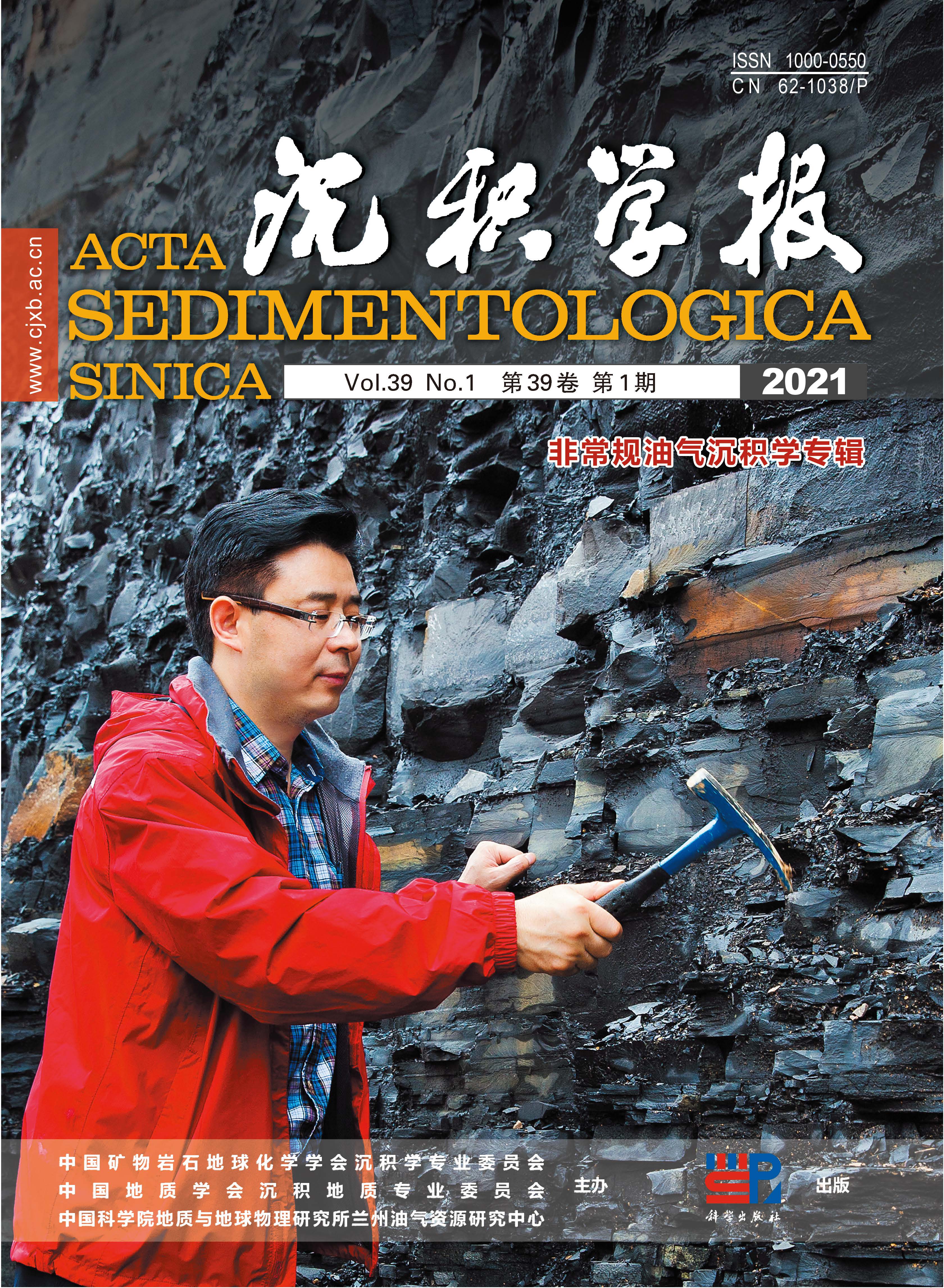


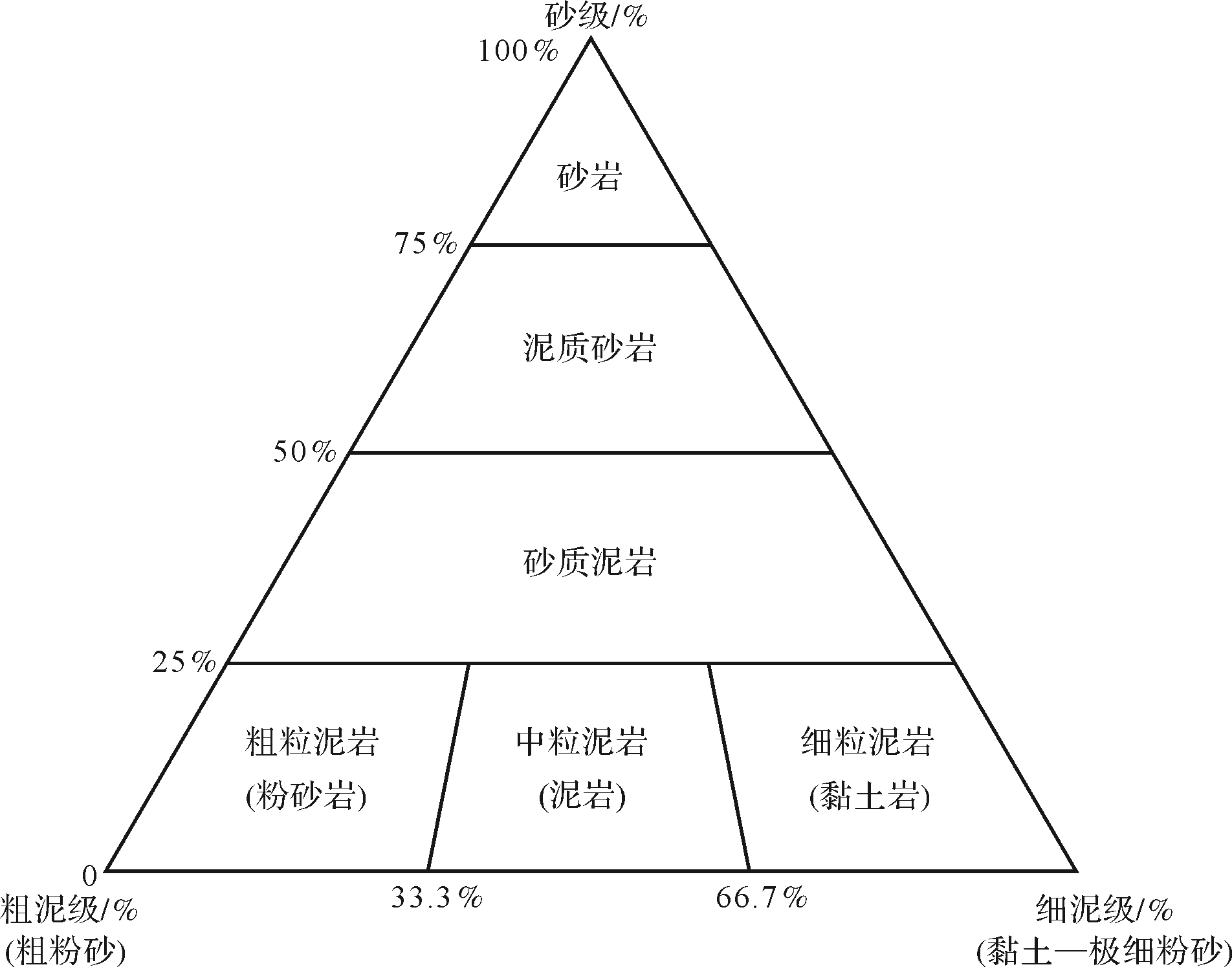








 DownLoad:
DownLoad:

